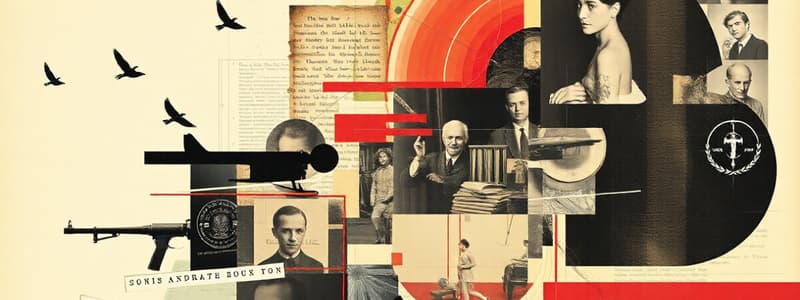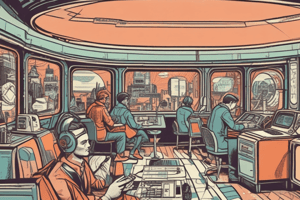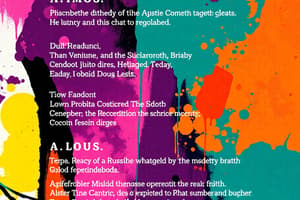Podcast
Questions and Answers
What is a text?
What is a text?
A simple and flexible format of presenting information or conveying ideas whether hand-written, printed or displayed on-screen; any “human-readable sequence of characters” that can form intelligible words.
How is text used in the following media?
How is text used in the following media?
Answers will vary.
What is a typeface also called?
What is a typeface also called?
Font, font type, or type.
Give an example of a serif typeface.
Give an example of a serif typeface.
Give an example of a decorative typeface.
Give an example of a decorative typeface.
What is DOC (document)?
What is DOC (document)?
What is RTF (Rich Text Format)?
What is RTF (Rich Text Format)?
What is PDF (Portable Document Format)?
What is PDF (Portable Document Format)?
What is PS (PostScript)?
What is PS (PostScript)?
What does emphasis refer to?
What does emphasis refer to?
What does appropriateness refer to?
What does appropriateness refer to?
What does proximity refer to?
What does proximity refer to?
What does alignment refer to?
What does alignment refer to?
What does organization refer to?
What does organization refer to?
What does repetition concern?
What does repetition concern?
What does contrast create?
What does contrast create?
Discuss text design principles and elements applied in the following media.
Discuss text design principles and elements applied in the following media.
If you will be writing an application letter for college, what font will you be using? Why?
If you will be writing an application letter for college, what font will you be using? Why?
You will create a cleanliness drive campaign poster for your school. Which of the design principle and elements will ensure that the text in your poster is readable?
You will create a cleanliness drive campaign poster for your school. Which of the design principle and elements will ensure that the text in your poster is readable?
You want to share your narrative report, which is in a word document format, to your classmates but you do not want them to edit its content. What options are available to you?
You want to share your narrative report, which is in a word document format, to your classmates but you do not want them to edit its content. What options are available to you?
Types of text that serve to link different electronic documents and enable users to jump from one to other in a nonlinear way.
Types of text that serve to link different electronic documents and enable users to jump from one to other in a nonlinear way.
Types of text that have fixed sized characters having essentially the same type of appearance
Types of text that have fixed sized characters having essentially the same type of appearance
Types of text whose appearance can be changed using font parameters (bold, underline, italic, font size, font color, etc.)
Types of text whose appearance can be changed using font parameters (bold, underline, italic, font size, font color, etc.)
Flashcards
What is text?
What is text?
A simple and flexible format of presenting information or conveying ideas whether hand-written, printed or displayed on-screen.
What is Hypertext?
What is Hypertext?
Serves to link different electronic documents and enables users to jump from one to another in a nonlinear way.
What is Plaintext?
What is Plaintext?
Fixed-size characters having essentially the same type of appearance.
What is Formatted Text?
What is Formatted Text?
Signup and view all the flashcards
What is a Typeface?
What is a Typeface?
Signup and view all the flashcards
What is Serif?
What is Serif?
Signup and view all the flashcards
What is Sans Serif?
What is Sans Serif?
Signup and view all the flashcards
What is Slab Serif?
What is Slab Serif?
Signup and view all the flashcards
What is Script Typeface?
What is Script Typeface?
Signup and view all the flashcards
What is Decorative Typeface?
What is Decorative Typeface?
Signup and view all the flashcards
What is TXT?
What is TXT?
Signup and view all the flashcards
What is DOC?
What is DOC?
Signup and view all the flashcards
What is RTF?
What is RTF?
Signup and view all the flashcards
What is PDF?
What is PDF?
Signup and view all the flashcards
What is PS?
What is PS?
Signup and view all the flashcards
What is Emphasis?
What is Emphasis?
Signup and view all the flashcards
What is Appropriateness?
What is Appropriateness?
Signup and view all the flashcards
What is Proximity?
What is Proximity?
Signup and view all the flashcards
What is Alignment?
What is Alignment?
Signup and view all the flashcards
What is Organization?
What is Organization?
Signup and view all the flashcards
What is Repetition?
What is Repetition?
Signup and view all the flashcards
What is Contrast?
What is Contrast?
Signup and view all the flashcards
Study Notes
- Media and Information Literacy (MIL) covers text information and media.
Learning Competencies
- Learners will define text in the context of multimedia
- Learners will describe the different dimensions of text information and media
- Learners will comprehend how text information and media is/are formally and informally produced, organized, and disseminated
- Learners will evaluate the reliability and validity of text information and media and its/their sources using selection criteria
What is Text?
- Text is a simple and flexible format for presenting information or conveying ideas whether hand-written, printed or displayed on-screen
- Text is any human-readable sequence of characters that can form intelligible words
Types of Text
- Hypertext links different electronic documents and enable users to jump from one to another in a nonlinear way
- Plaintext or unformatted text has fixed sized characters with essentially the same type of appearance
- Formatted text appearance can be changed using font parameters like bold, underline, italic, font size, and font color
What is a Typeface?
- Typeface, also called font, font type, or type, refers to the representation or style of a text in the digital format
- Typeface is usually comprised of alphabets, numbers, punctuation marks, symbols and other special characters
Types of Typefaces
- Serif connotes formality and readability in large amount of texts
- Serif typeface is usually used for the body text of books, newspapers, magazines and research publication
- Serif typeface gives a classic or elegant look when used for title or heading
- Examples of serif typefaces include Times New Roman, Garamond, and Baskerville
- Sans Serif brings a clean or minimalist look to the text
- Sans Serif is used for clear and direct meaning of text such as road signage, building directory or nutrition facts in food packages
- Sans Serif gives a modern look and is used primarily in webpage design
- Examples of Sans Serif typefaces include Arial, Helvetica, Tahoma, Verdana, and Calibri
- Slab Serif carries a solid or heavy look to text
- Slab Serif can be used for large advertising signs on billboards
- Examples of Slab Serif typefaces include Rockwell and Playbill
- Script typeface draws much attention to itself because of its brush-like strokes
- Script typeface must be used sparingly and not to be used in large body text
- Script typeface is usually used in wedding invitation cards or other formal events
- Examples of Script typefaces include Edwardian, Vladimir, and Kunstler
- Decorative typeface caters to a wide variety of emotions or themes
- Examples of Decorative typefaces include Chiller, Jokerman, and Curlz MI
Common File Formats
- TXT (text) is an unformatted text document by an editor as notepad on Windows platform
- DOC (document) is a native format for storing documents created by MS Word package, containing formatting capabilities
- RTF (Rich Text Format) is a cross platform document exchange and is the default format for Mac OS X's default editor TextEdit
- PDF (Portable Document Format) is developed by Adobe systems for cross platform exchange of documents and supports images and graphics
- PS (PostScript) is a page description language used mainly for desktop publishing
Design Principles and Elements
Emphasis
- Refers to the importance or value given to a part of the text-based content
- To make a point or highlight a message, text can be made bold, italicized, have a heavier weight, darkened or lightened (depending on background color) or enlarged
Appropriateness
- Appropriateness refers to how fitting or suitable the text is used for a specific audience, purpose or event
- For the choice of typefaces to be used, refer to the discussion of the characteristics of the fonts
Proximity
- Refers to how near or how far are the text elements from each other
- When two things are closely related, they are brought close together
- The main title and subtitle are usually placed close to each other
Alignment
- Alignment refers to how the text is positioned in the page, whether left, center, right, or justified
Organization
- Organization refers to a conscious effort to organize the different text elements in a page
- Organization ensures that while some text elements are separated from each other (based on the principle of proximity), they are still somehow connected with the rest of the elements in the page
Repetition
- Repetition concerns consistency of elements and the unity of the entire design
- Repetition encourages the use of repeating some typefaces within the page
Contrast
- Contrast creates visual interest to text elements
- Contrast is achieved when two elements are different from each other
- Contrast can be achieved in various ways, by joining the following elements: white text on a dark background, dark text on a white background, large font with a small font, serif and sans serif, thin elements with thin elements, cool color and warm color
Studying That Suits You
Use AI to generate personalized quizzes and flashcards to suit your learning preferences.





